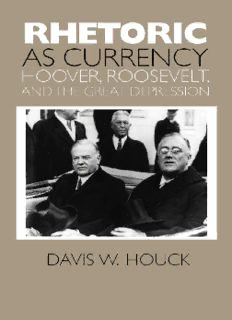
Rhetoric as Currency: Hoover, Roosevelt, and the Great Depression PDF
Preview Rhetoric as Currency: Hoover, Roosevelt, and the Great Depression
Rhetoric as Currency Number Four: Presidential Rhetoric Series Martin J. Medhurst, General Editor In association with The Center for Presidential Studies George Bush School of Government and Public Service Davis W. Houck Rhetoric as Currency Hoover, Roosevelt, and the Great Depression Texas A&M University Press College Station Copyright © 2001 by Davis W. Houck Manufactured in the United States of America All rights reserved first edition Davis Houck, “Reading the Body in the Text: FDR’s 1932 Speech to the Democratic National Convention,” The Southern Communication Journal 63 (1997), 20–36. Reprinted with the permission of the Southern States Communication Association. “Rhetoric as Currency: Herbert Hoover and the 1929 Stock Market Crash,” Rhetoric and Public Affairs 3, no. 2 (2000). Reprinted with the permission of Michigan State University Press. Lyrics from “Blood Brothers” by Bruce Springsteen, copyright 1995 by Bruce Springsteen (ASCAP), reprinted with permission. Lyrics from “Reason to Believe” by Bruce Springsteen, copyright 1982 by Bruce Springsteen (ASCAP), reprinted with permission. The paper used in this book meets the minimum requirements of the American National Standard for Permanence of Paper for Printed Library Materials, Z39.48-1984. Binding materials have been chosen for durability. (cid:1)(cid:2) Library of Congress Cataloging-in Publication Data Houck, Davis W. Rhetoric as currency: Hoover, Roosevelt, and the Great Depression/Davis W. Houck.—1st ed. p. cm.—(Presidential rhetoric series ; no. 4) Includes bibliographical references and index. ISBN 1-58544-109-0 1. Communication in politics—United States. 2. United States—Economic conditions—1918–1945. 3. United States—Economic policy. 4. Depressions—1929—United States. I. Title. II. Series. JA85.2.U6 H68 2001 330.973(cid:1)0916—dc21 To Roy Engle: “We played king of the mountain out on the end The world came chargin’ up the hill, and we were women and men . . . But the stars are burnin’ bright like some mystery uncovered I’ll keep movin’ through the dark with you in my heart My blood brother.” —Bruce Springsteen, “Blood Brothers” Contents Preface ix One: Introduction 1 Two: “Talk is Cheap” Herbert Hoover Responds to the Great Depression 17 Three: Recontextualizing the Depression War, Christianity, Confidence, and Silence 54 Four: “A Satisfactory Embodiment” FDR’s “Run” for the Nomination 94 Five: Making House Calls Health, Sickness, and the “Body” Economic 139 Six: Rhetoric, Silence, and the “Scene” of War The Interregnum and the First 100 Days 168 Seven: Serendip 195 Bibliography 205 Index 221 Preface The beginnings of this book date well before my formative years in graduate school, back to those heady days now known as “The Reagan Revolution.” Contrary to what my professor of microeconomics was teaching, I discov- ered that the “economy” wasn’t a carefully delineated and circumscribed se- ries of assumptions. Nor was it a mathematically precise and elegantly drawn diagram on a blackboard. Rather, it was a story. It was a drama with heroes and villains. And it was moved by how we were moved. This book represents another part of that story, told from the vantage points principally of Herbert Hoover and Franklin D. Roosevelt. It was in- tended originally to be a study of the Roosevelt administration’s famous first 100 days. I wanted to see firsthand just how the heroic FDR saved capitalism in three short months. Even a lousy storyteller couldn’t mess this one up. And then along came Herbert Hoover, the grim-faced villain of countless renderings of America’s Great Depression. In what was supposed to be merely “background” reading, it became clear that Roosevelt’s story couldn’t be told without Hoover. Or, perhaps the better word is “shouldn’t.” To make sense of those first 100 days, Hoover must be in the foreground, seated next to FDR just like that infamous Inauguration Day ride of March4, 1933. Popular memory has inscribed FDR’s inaugural aphorism— “the only thing we have to fear is fear itself”—into the lexicon of the Amer- ican story. It was sentiment lifted right out of the Hoover years. Hoover and Roosevelt both understood that the Great Depression was “Great” largely because of a collective state of mind. The “story” had lost its way, and thus had millions of Americans. Legislatively sponsored macro- economic policy was only a partial solution to a much more profound prob- lem. That was the problem of belief. It was also a macroeconomic problem. And because it was a question of collective belief it was also a rhetorical problem. This is a book about those rhetorical problems and their attempted rhetorical solutions. I suppose that it’s appropriate in a book ostensibly about money to note some of the debts that I’ve incurred in writing this book—and to repay them, at least textually. Dick Gregg advised the dissertation, where this book initially got its legs. The highest praise that I can give him is that he enabled me to write the dissertation that I wanted to write—warts and all. Marty Medhurst helped me to excise many of those warts; more im- portantly, his constant encouragement and enthusiasm for the project
Description: